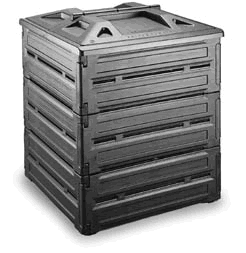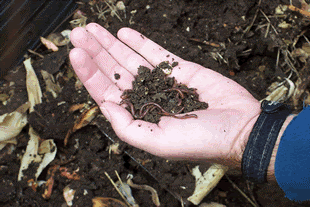- TABLE OF CONTENTS
- DESIGN
- Introduction to Design
- Active Family
- Empty Nesters
- Young Professionals
- Questionnaire
- Principles of Design
- Design Concepts
- Working With Professionals
- Drainage
- Soil
- Climate/Weather
- Safety
- Landscape & Irrigation Plans
- Landscape Design
- Installing the Garden
- Hydrozoning
- Public and Demonstration Gardens
- Xeriscape
- Garden Care
- Composting
- Lawn
- Maintaining Your Garden
- Plant Water Needs
- Mulch
- Pest Management
- Growing a Healthy Garden
- Reading a Pesticide Label
- Pruning Landscape Plants
- Planting Instructions
- IRRIGATION
- Irrigation 101
- Types of Irrigation Systems
- Upgrading Existing System
- Choosing an Irrigation Control System
- Irrigation, Maintenance and Troubleshooting
- Eliminating Run-off and Overspray
- Acknowledgments
Composting
Composting, nature's own way of recycling, is the controlled aerobic decomposition of organic material, such as leaves, twigs, grass clippings, fruit and vegetable food waste. Compost is a soil amendment product that results from proper composting techniques. Whether it's done on-site, at the point of waste generation, or in a large-scale, centralized facility, composting helps to keep the high volume of organic material out of landfills and turns it into a useful product. Large-scale facilities can handle more material and potentially produce a more consistent product but may be faced with regulatory issues. On-site composting reduces the cost of hauling materials and is generally exempted from solid waste regulations.
Bin/Pile Information
Composting can be practiced in most backyards using a homemade or manufactured composting bin or simply an open pile (some cities do require enclosed bins). Businesses, schools, and other facilities can also easily compost. Homemade bins can be constructed out of scrap wood, chicken wire, fencing, hay bales, or even old garbage cans (with holes punched in the sides and bottom). Manufactured bins include turning units, hoops, cones, and stacking bins. These can be purchased from retail or mail order businesses.

Biostack compost bin
Ingredients
While a multitude of organisms, fungi, and bacteria are involved in the overall process, there are four basic ingredients for composting: nitrogen, carbon, water, and air. Composting is a lot like cooking, and the easiest compost recipe calls for blending roughly equal parts by volume of green or wet material (which is high in nitrogen) (e.g., coffee grounds, food waste, garden waste, grass clippings, hay, manures, vegetable scraps) and brown or dry material (which is high in carbon) (e.g., wood ash, shredded cardboard, corn stalks, fruit waste, leaves, shredded newspaper, straw, wood chips). This will result in a close approximation of the ideal 30:1 ratio of carbon to nitrogen. Simply layer or mix these materials in a pile or enclosure, chop or shred large pieces to 12" or shorter, keep moist and turn materials often to add air. Then leave it to the microorganisms to decompose the material over time.
Nitrogen
Green materials, such as grass clippings and landscape trimmings, are ideal sources of nitrogen for composting. Vegetable and fruit trimmings can also provide nitrogen. To reduce the potential for pests or odors, it is best to: 1) avoid meat or dairy scraps and 2) bury any food scraps deep within the compost pile.
Carbon
Brown (dry) yard and garden material, such as dry leaves, twigs, or hay, can provide the carbon balance for a compost pile. Chop or shred large pieces to 12 inches or shorter (thick, woody branches should be chipped, ground up, or left out). Untreated wood chips and sawdust are a powerful carbon source that may be useful if the pile contains excess nitrogen.
Water
One of the more common mistakes in composting is letting the pile get too dry. A compost pile should be as moist as a wrung-out sponge. Moisture content of 40 to 60 percent is preferable. To test for adequate moisture, reach into your compost pile, grab a handful of material, squeeze it, and if a few drops of water come out, it probably has enough moisture. If it doesn't, add water. When watering, it is best to put the hose in the pile. During dry weather, you may have to add water regularly. During wet weather, cover the pile. A properly constructed compost pile will drain excess water and should not become soggy.
Air
The bacteria and fungus in the compost pile need oxygen to live and work. If the pile is too dense or becomes too wet, the air supply will be cut off and the beneficial organisms will die. Decomposition will also slow down and an offensive odor may arise. To avoid this and speed the process, turn and fluff the pile with a pitchfork weekly.
Size
Ideally, the compost pile should be at least three feet wide by three feet deep by three feet tall (one cubic yard). This size provides enough food and insulation to keep the organisms warm, happy, and working hard. However, piles can be larger or smaller and work just fine if managed well.
How to Tell When It's Done
Your compost is finished when the original material has been transformed into a uniform, dark brown, crumbly product with a pleasant, earthy aroma. There may be a few chunks of woody material left; these can be screened out and put back into a new pile. You may want to stop adding to your compost pile after it gets to optimal size (see above) and start a new pile so that your first pile can finish decomposing (during which time the temperature will drop).
Compost:
Types of amendments to avoid:
| • | Avoid compost with deactivated sludge (solid waste from sewer treatment plants). These typically have high levels of salts and some heavy metals. |
| • | Avoid manure compost which can also have high levels of salts and can be washed off the garden from sprinklers that overspray or create runoff. |
| • | Avoid green compost or compost made from fresh tree shavings. |
Vermicomposting
Vermicomposting, or composting with earthworms, turns kitchen waste into high-quality compost.
According to the Natural Resources Conservation Service (NRCS), "two pounds of worms can recycle one pound of kitchen scraps in only 24 hours!" Here are additional sites for more information:
http://lancaster.unl.edu/pest/resources/vermicompost107.shtml
http://journeytoforever.org/compost_worm.html

A delicious mixture of composted kitchen and
yard waste and worms.
Give it a Try!
Home composting and Vermicomposting are best learned by doing. There are a number of books written on backyard composting; check your local library or bookstore. Also check with your local government for workshops, handouts, or guides on composting.
For more information:
California Integrated Waste Management Board - http://www.ciwmb.ca.gov/Organics/Gardening/
Master Composters - http://www.mastercomposter.com
Cornell University - http://compost.css.cornell.edu/Composting_homepage.html
Fresno UC Cooperative Extension Office
1720 South Maple Avenue
Fresno, CA 93702-4516
(559) 456-7285
Click here for Master Gardeners of Fresno County local composting and vermiculture resources.
Kearney Research & Extension Center
9240 South Riverbend Avenue
Parlier, CA 93648
(559) 646-6000